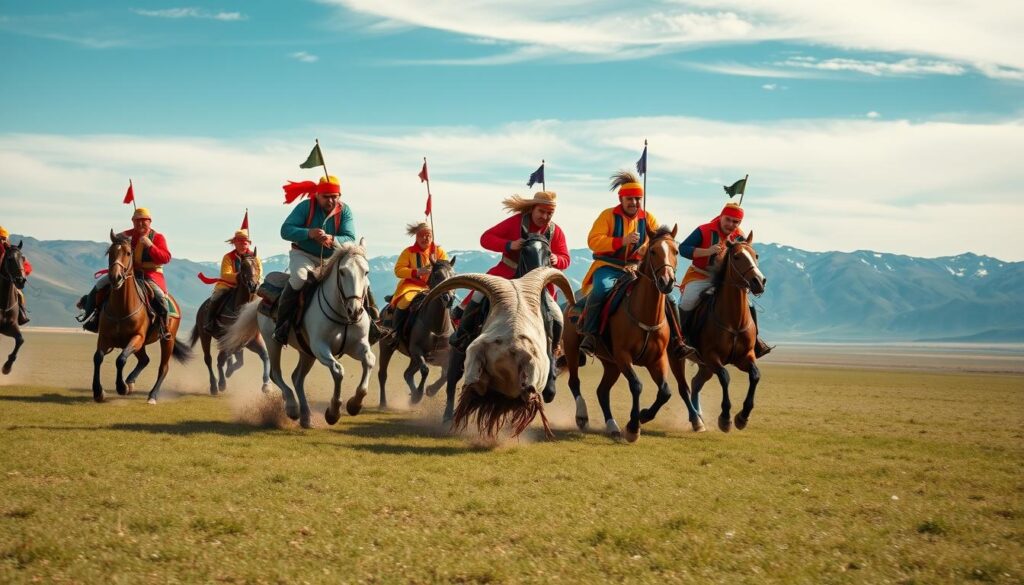As I stepped onto the sun-drenched plains of the Great Steppe, the energy of the World Nomad Games enveloped me. The rhythmic beat of hooves and the roar of the crowd filled the air. It ignited a sense of wonder and cultural immersion I had never experienced before. This international spectacle, a testament to the resilience and traditions of the nomadic peoples of Central Asia, was about to unfold before my eyes.

The World Nomad Games, a biennial event held in the Kyrgyz Republic, celebrates the nomadic heritage of the region. As I watched athletes compete in traditional sports, I felt a deep connection to the timeless traditions passed down through generations. From the exhilarating horseback games to the precise art of eagle hunting, each event showcased the resilience and skill of the Great Steppe’s people.
In this article, we’ll explore the rich cultural tapestry of the World Nomad Games. We’ll look at the ethnic diversity that makes these games unique and how they preserve the nomadic way of life. Join me as we journey through Central Asia, where the spirit of the Great Steppe comes alive in a captivating display of athleticism, camaraderie, and cultural pride.
Celebrating the Nomadic Heritage of Central Asia
The World Nomad Games are a celebration of nomadic heritage in Central Asia. They highlight the ethnic diversity of the Great Steppe. The event showcases the region’s cultural traditions through various games and competitions.
The Ethnic Diversity of the Great Steppe
The Great Steppe is home to many ethnic groups. Kazakhs, Kyrgyz, Turkmen, and Uzbeks have shaped Central Asia’s culture. The World Nomad Games celebrate this ethnic diversity, letting visitors experience the unique customs of these communities.
Preserving Cultural Traditions Through Games
The World Nomad Games focus on preserving cultural traditions. They feature traditional games and competitions. These activities show the spirit and resilience of the region’s nomadic peoples.
By celebrating nomadic heritage, the World Nomad Games invite everyone to explore ethnic diversity and cultural traditions in Central Asia.

Thrilling Traditional Games of the Nomads
The World Nomad Games highlight the traditional games loved by nomadic communities in Central Asia. These games show the amazing skills and endurance of the players. They are a big part of the nomadic way of life.
At the World Nomad Games, you can see the “Three Games of Men.” These games are a big part of the nomadic heritage.
- Kok-Boru: This game is like “dead goat polo.” Teams ride horses and try to toss a goat carcass into the other team’s goal.
- Ordo: It’s a strategic board game. Players move their pieces on a grid to capture their opponent’s tokens.
- Toguz Kumulak: This game tests mental agility. Players place stones or nuts in a wooden board with grooves.

These games are deeply rooted in Central Asia’s nomadic heritage. They show the competitive spirit, cultural importance, and skill of the players.
World Nomad Games put the spotlight on the sport of the Great Steppe
The World Nomad Games have highlighted the traditional sports of the Great Steppe. They show the rich cultural heritage of Central Asia. The horseback game of Kok-Boru is a thrilling event that showcases the skill and bravery of nomadic horsemen.
Kok-Boru: The Fierce Horseback Game
Kok-Boru, also known as “dead goat polo,” is a fast-paced sport played for centuries. Two teams, each with up to 10 players, try to carry a goat carcass to their goals. They do this while riding horses with amazing agility and precision.
This sport requires great horsemanship. Players must control their horses while trying to get the goat to their goal. The game is intense, with players often fighting for control.

Kok-Boru is more than a game; it reflects the nomadic way of life. It shows the importance of horse control and agility in the harsh Great Steppe environment. The sport’s origins are linked to hunting and herding, essential for survival.
The World Nomad Games have made Kok-Boru famous worldwide. Now, people everywhere can see the power and skill of these nomadic horsemen. They perform a tradition that is deeply rooted in their culture.
Horseback Archery: A Test of Skill and Precision
The World Nomad Games feature horseback archery. Riders show off their skill by hitting targets while riding fast. It’s a tough sport that needs lots of practice to master.
Riders must control their horses and shoot arrows accurately. This requires a lot of skill and focus.
The Ancient Art of Eagle Hunting
Eagle hunting is another sport at the games. It’s a tradition where people train eagles to help hunt small animals. This shows the deep connection between nomadic people and nature.
People watch in awe as eagles fly and catch prey. It’s a display of their strength and grace.
The World Nomad Games celebrate the Great Steppe’s culture. Horseback archery and eagle hunting are key parts of this. They show the bravery and skill of nomadic people.






